The Indian Child Goes To School
APPENDIX D
Levels of Achievement
Differential Diagnosis on Achievement Profiles
| Table D- 1 |
5% and 1% Levels of Significance of Differences in T-Scores-Elementary
Level |
| Table D-2 |
5% and 1% Levels of Significance of Differences in T-Scores-Intermediate
Level |
| Table D-3 |
5% and 1% Levels of Significance of Differences in T-Scores-Advanced
Level |
| Table: D-4 |
Phoenix Area Norm Tables (Fail) California Achievement Tests |
LEVELS OF ACHIEVEMENT
A reference was made in Chapter VII
as to how a distribution of raw scores for one grade in an area
may be
stratified for an interpretation of meaningful levels of achievement.
These levels are determined by the three raw score points in a
grade distribution nearest to the mean and plus and minus one standard
deviation from the mean. The standard deviation may be described
as the average distance of all scores from the mean of a distribution
of scores. Thus the raw scores within the range of plus and minus
one standard from the mean may be considered average scores. They
will include about 68% of the cases. The 34% of the scores between
the mean and +1 S. D. may be called high average, while the 34%
between the mean and -1 S. D. may be called low average. The achievement
of the 16% of individuals scoring above +1 S. D. may be called
high, while the achievement of the 16% scoring below -l S. D. may
be characterized as low.
Table D- 1 presents the raw score limits
for each level of achievement on each of the seven tests for
each grade in the Anadarko area
(and combined with the Muskogee area on the advanced level).
Similar tables have been prepared for each of the other areas.
DIFFERENTIAL
DIAGNOSIS ON ACHIEVEMENT PROFILES
When a battery of tests is administered
to a group of individuals, three major problems of the interpretation
of scores arise: the comparability of scores of one test with those
of another; the significance of the difference of scores on the
same test; and the significance of the difference o~ scores on
different tests.
The problem of comparability asks the question:
What scores on all the other tests are equivalent to a score of
x on test X? In
this study comparability was obtained on each level of the California
Achievement Test by normalizing the distributions of scores, plotting
each on the same scale of T-scores, and using the distributions
of the same group in an area to obtain normalized standard scores
for all seven tests.
The problem of the significance of difference
of scores on the same test poses the question: Taking chance variation
into account,
when can we say that two scores are most probably different scores;
i. e., one Is really higher or lower than another? The standard
error of measurement was calculated for each test on a level, prior
to which reliability coefficients were obtained. Raw scores were
plotted on the profile approximately one standard error apart.
A difference in raw scores exceeding two standard errors may be
expected less than five times in a hundred by chance alone
The third
problem, of the significance of difference of scores on different
tests, asks the question: When can we say that the
achievement on one test Is really higher than on another? In Chapter
VII reference was made to a “rule-of-thumb” that a
difference as great as or greater than 8 T-scores between two different
tests could be considered significant. A short explanation as to
the method of obtaining this amount is in order.
A t-test can be made to test the probability level of every
possible difference between each of the tests by using the formula:
A
simpler way is to establish the t value for the desired level
of confidence (.05 or .01) and to solve for the z score difference
on each pair of tests, using their respective reliability coefficients.
These differences were calculated for the five per cent and one
per cent levels of confidence for each pair of tests on each level
in each area. The average T-score difference (ten times the z score
difference) at the five per cent level in all areas was found to
be about 8. Thus the “rule-of-thumb” was found to be
fairly consistent through all the areas.
The calculated values of
difference in T-scores In the Anadarko area for both the five per
cent and one per cent levels are shown
in the accompanying tables. On the advanced level the Anadarko
and Muskogee areas were combined, it will be recalled.
The tables
may be interpreted as in the following illustration. In Table D-l,
we see that a difference of nine T-scores or more
between reading vocabulary and spelling may be expected less than
five times in a hundred by chance alone. A difference of twelve
T-scores or more on these two tests may be expected less than one
time in a hundred by chance alone. These differences are considered
significant on their respective levels of confidence. For speed
in interpreting profiles the “rule-of-thumb” may be
considered adequate.
APPENDIX E
Letter of February 9, 1951, from E. Gordon Collister
to Willard W. Beatty, Proposing the Content of the Predictive
Test Battery
Letter of February 12, 1951, from L. Madison Coombs
to the Area Directors, Advising Them of Preliminary Planning
for Predictive
Testing
Letter of February 27, 1951, from L. Madison Coombs
to the Area Directors, Advising Them of Specific Procedures for
Predictive
Testing
Application Form for the Predictive Test Battery
Table E-1 Intercorrelations
of Scores on the Test Battery for Haskell Commercial A~pplicants,
1951-54
Table E-2 Test Battery for Haskell Commercial-Standard
Errors of Measurement and Reliability Coefficients
Table
E-3 Expectancy Tables for Pass and Fail Groups Haskell Commercial
Program, 1951-54
February 9, 1951
Dr. Willard W. Beatty
Director of Indian Education
Bureau of Indian Affairs
New Interior Building
Washington 25, D. C.
Dear Dr. Beatty:
After several discussions with Mr. Coombs and
Mr. Kelley, the following battery is suggested for use with Indian
students applying for
educational loans or admission to Haskell.
Test |
Time |
| Otis Quick-Scoring Mental Ability Test (Gamma) |
30 min. |
| Cooperative General Achievement Test-Proficiency in Mathematics |
40 min. |
| Cooperative English Test (single booklet edition -lower level) |
|
Ci - Reading Comprehension
|
40 min. |
A - Mechanics of Expression
|
40 min. |
B1 - Effectiveness of Expression
|
40 min. |
Guilford- Zimmerman Temperment Surev
|
untimed |
| |
(Approximately 60 mm.) |
For students requesting admission to the commercial sequence at
Haskell, we suggest substituting the Hundred-Problem Arithmetic
Test (Schorlung-Clark-Potter)
for the Cooperative Mathematics Test. Provided replacement costs for test materials
do not soar, the estimated cost for this battery is $.75 per Individual. This
includes the cost of the test materials, answer sheets, profiles, scoring,
use of electrographic pencils, and postage for mailing tests and test reports.
It is our understanding that the individual applicant will pay a fee of $50
and for the remainder of this fiscal year the balance of the cost will be drawn
from our contract funds.
With the exception of the Hundred-Problem Arithmetic
Test none of the above tests Involve a very short time limit for
a subtest. This reduces the importance
of small timing errors.
The Otis test is suggested since we already have Information
from previous testing programs that may lead to meaningful comparisons.
Since the content
of the Cooperative Mathematics test is not particularly suited to the areas
Important In the Haskell commercial department, we suggest the use of a test
dealing specifically with fundamental arithmetical operations for
applicants to this program.
In our discussions there was a difference
of opinion regarding the Cooperative English Test. There was agreement
on the use of part C1 - Reading Comprehension.
The use of both A - Mechanics of Expression and B1 - Effectiveness
of Expression was questioned. The content of subtest A deals with material
usually associated
with drill work in many English courses. To this extent the content will probably
be familiar to students. The content of subtest B1 is not as susceptible
to practice and apparently is closely associated with the usual “Freshman
Composition.” To have a complete picture of the English background of
an individual student it is felt that the three subtests are important.
There
was considerable discussion regarding the use of the Guilford-Zimmerman Temperament
Survey. It was suggested that decisions concerning the granting
of an educational loan would not be based on the results of this Instrument.
In addition, the findings reported in the Educational Records Bureau study
indicated that personality ratings did not add to the prediction of college
success. It should be noted that the latter conclusion is based on the use
of personality ratings. We cannot make the same statement concerning the
use of scores on a personality inventory although it is not expected
that any correlation
with college success would be particularly high. The most important use of
personality data appears to be for research purposes. If, at some later date,
a follow-up study of applicants is contemplated, the time to obtain personality
estimates is at the same time other test data are collected. For this reason
the use of the Guilford-Zimmerman is suggested.
There are several general
considerations which are important.
- The tests suggested are not “easy.” The
battery may be criticized as being too difficult for the background
of some of the Indian students. However,
the people taking this battery will be a highly select group from the
total group of Indian students. Since the question at issue
is not one of general
level of achievement but one of ability and preparation for advanced
study, test instruments suitable for this purpose should be
used.
- The impact of a battery of this type on the individual
student is of considerable importance. Mr. Coombs has already
raised this question and
is considering
means of ameliorating the problem.
- It may appear that the length
of the battery is excessive. Considering the importance of
the questions to be answered, it is not felt that
this objection
is valid.
- Tests in the areas of natural science and social studies
have not been included in the battery. Perhaps they should
be considered
for
use at some
future time
when the fields of specialization for college students are known.
In case
you do not have copies of the suggested test, Mr. Kelley has a set with
him for your use. We will await a reply from you before proceeding
with further arrangements. Tests will be ready for distribution
two weeks from the receipt
of your reply.
Yours truly,
E. Gordon Collister
Director
February 12, 1951
Mr. Allan C. Harper, Area Director
Office of Indian Affairs
Window Rock Area Office
Window Rock, Arizona |
Attn: Hildegard Thompson
Director of Navajo Schools |
Dear Mr. Harper:
This letter is for the purpose of bringing you
up to date on future plans of the Service-Wide Testing Program
with the thought that
you will wish to pass this information on to reservation and school
principals in your area at the earliest opportunity.
During the
period December 11 to 14 inclusive, a conference was held at Haskell
Institute for the purpose of reviewing the Indian
Education Evaluation Program and charting its course for me future.
The meeting was attended by the following representatives of the
Indian Service: Mr. Willard W. Beatty, Chief of the Education Branch;
Dr. George Dale, Education Specialist, Research; Mr. Earl Intolubbe,
Education Specialist, Supervisor of Guidance; and Madison Coombs,
Education Specialist and Director of the Service-Wide Testing Program.
Dr. Kenneth E. Anderson, Director of the Bureau of Research and
Service; Mr. Gordon Collister, Director of the Guidance Bureau;
and Mr. Carl Ladd, graduate assistant, represented the University
of Kansas.
The following decisions of immediate importance to you
and your personnel were made:
(1) There will be no achievement testing
for survey purposes on a nation-wide basis this year. Since
the University of Kansas has
recently assumed the responsibility of serving as consultant to
the program, it was felt that the University men should have an
opportunity to make a thorough study of what has been done in the
past, to survey the instruments which have been used, and to have
a hand in planning any future cycle of testing. Testing on a service-wide
basis will be resumed during the 1951-52 school year. (2) The administration
of tests to 12th graders who wish to be considered for educational
loans or who make application for admission to the Haskell Commercial
Department will be continued this spring, if present plans materialize.
The selection of tests to be used for this guidance function is
in process. It is not presumed that all 12th graders will be tested,
but only those, both in our Indian Service schools and mission
and public schools, for whom we need predictive data relative to
their pursuing an education at the post high school level. Detailed
information concerning the procedure to be followed will be sent
out from this office soon. (3) A statistical analysis of the result
of last spring’s achievement testing and interpretation of
the data will be completed by the University of Kansas as soon
as possible. (4) An effort will be made to validate instruments
used in the past for the purpose of predicting success in college
by making comparative studies between scores on the tests and the
student’s success at the college level. These tests would
include the Gates Basic Reading, Pressey English, and the Factorial
Abilities Series, among others.
Inasmuch as we had tentatively planned
at one time to do survey testing early in the current semester,
I felt that the above information
should be passed on to you so that you and your school personnel
would know that time would not need to be allotted for this purpose
this year.
Sincerely yours,
L. Madison Coornbs
Education Specialist
Indian Service Testing Program
Approved: Solon G. Ayers
Superintendent
February 27, 1951
Mr. William Wade Head, Area Director
Office of Indian Affairs
Federal Building
Anadarko, Oklahoma |
Attn: Mr. Henry Wall
Area Supervisor of Education |
Dear Mr. Head:
As promised in our letter of February 12, paragraph
3, item 2, this letter will acquaint you with plans and procedures
for the
testing this spring of 12th grade students who wish to be considered
for educational loans or for admission to the Haskell Institute
commercial training course. Inasmuch as the new plan represents
a considerable departure from procedures used in recent years,
the plan will be described in some detail below.
1. The test battery
has been adopted upon the recommendation of the Guidance Bureau
of the University of Kansas and has been approved
by Mr. Willard W. Beatty, Chief of Education Branch, and Mr. Earl
C. Intolubbe, Education Specialist, Guidance. The battery will
consist of the following tests:
Test |
Time Limit |
| Otis Quick Scoring Test of Mental Ability (Gamma) Cooperative
English Test (single booklet edition lower level) |
30 minutes |
C1 Reading Comprehension
|
40 minutes |
A Mechanics of Expression
|
40 minutes |
Bl Effectiveness of Expression
|
40 minutes |
| Guilford- Zimmerman Temperament Survey - untimed |
Approx. 60 min. |
| Cooperative General Achievement Test - Proficiency in Mathematics
(for educational loan applicants) |
40 minutes |
Hundred-Problem Arithmetic Test (Schorling-Clark-Potter)
(for Haskell commercial applicants) |
40 minutes |
These tests cover most of the basic skills
which are important to academic success and therefore should have
validity in predicting
academic success or
failure at the post high school level. We anticipate a universal reaction that
the tests are relatively difficult. While this is true, we wish to point out
that the purpose of the tests is to aid in predicting success or failure In
college, nurse’s training, or the commercial course, and not to measure
achievement in high school. They should prove more discriminating as between
individual students than “easier” tests would be. It cannot be
emphasized too strongly that no student will be expected to answer all of the
Items correctly. An important advantage of most of the tests selected is that
percentile norms for entering college freshmen are available for them. It is
suggested that you exercise considerable discretion about revealing, in advance
of testing, the names of the tests which comprise the battery.
2. The batteries will be available for distribution about March 15 by the Guidance
Bureau of the University of Kansas. You are being supplied, under separate
cover, with forms on which the applicant will place his order with the Guidance
Bureau. The applicant is required to include a fee of 5Ocents with his order
to partly defray the cost of tile battery and the processing thereof. Also
we are requiring that the applicants high school or reservation principal or
area educationist approve the order so that we may be assured that the battery
is being mailed to a proper person for administration. It is felt that the
5O cent fee will not preclude any persons taking the tests or work a hardship
but will serve to emphasize the importance of the tests and cause the applicant
to feel that he has made a small investment in his future.
3. The battery, together
with explicit instructions for administering, will be mailed to the person
who is to give the test. Some of the tests will have
answer sheets and special pencils for machine scoring. All of the tests
and answer sheets will be returned to the Guidance Bureau for scoring.
It is recommended that whenever possible the battery be administered
during parts of three different
days, over the span of a week, to lessen the impact of the battery. In cases
where this is not feasible or where a hardship would be occasioned thereby,
the tests may all be given in one day but a full day should be Set aside
for the purpose with provision for adequate rest periods.
4. It
is recognized that the persons to whom this is addressed have a difficult
problem to solve in setting up an organization for the administration of
these tests. Principals of our own Indian Service high schools will undoubtedly
want
to test all of the applicants from their school at one time. Consequently
they will probably prefer to send all of their application forms and fees
to the
Guidance Bureau together. Testing of mission and public school applicants
will probably present more of a problem. You may wish to designate boarding
schools
in your area as testing centers. The main concern of this office is that
the persons giving the tests prepare themselves carefully by studying the
directions
and that they adhere to them closely.
5. One copy of the test results for
educational loan applicants will be sent to Mr. Intolubbe, Supervisor
of Guidance, and one to the educationist
of
the area in which the applicant took the test. Copies of test results
for commercial
course applicants will be Sent to Mr. Intolubbe, Haskell Institute, and
the area educationist.
If you have questions which are not answered in
this letter do not hesitate to write us at any time. We wish
to be of help in any way possible.
Sincerely yours,
L. Madison Coombs
Education Specialist
Indian Service Testing Program
Approved:
Solon G. Ayers
Superintendent
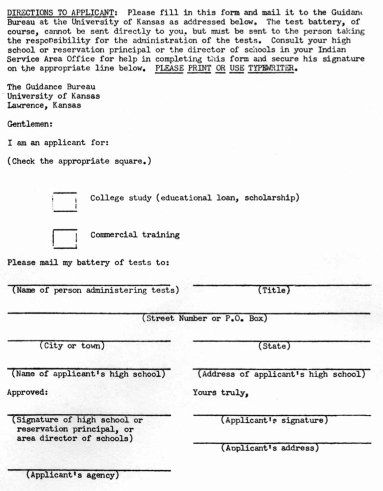
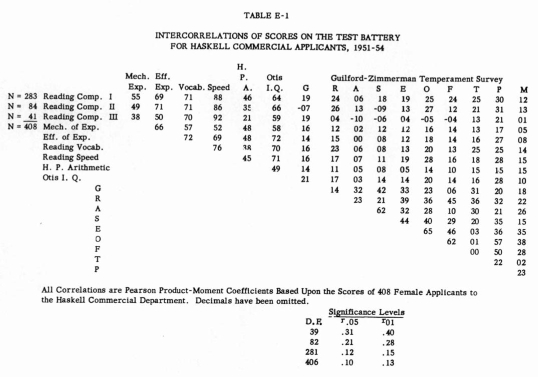
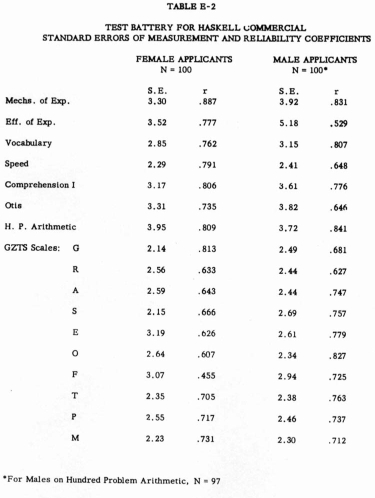
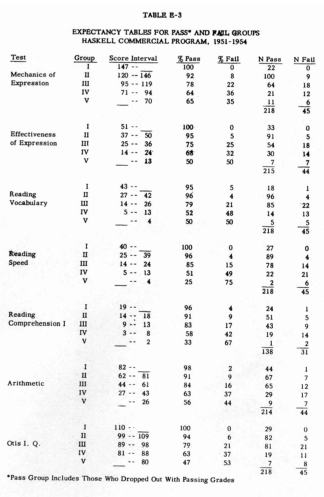
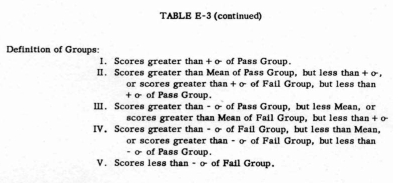
|